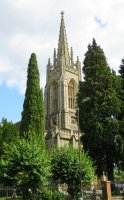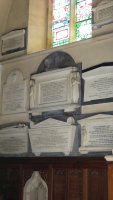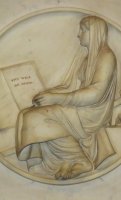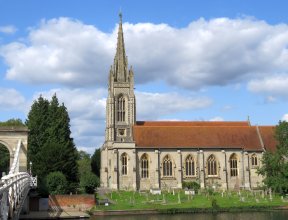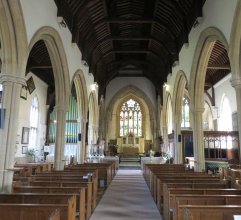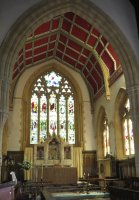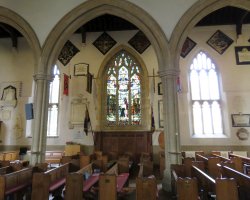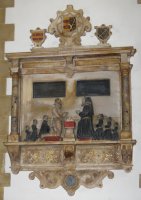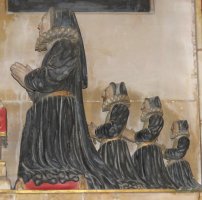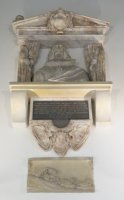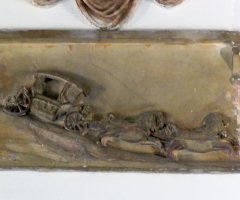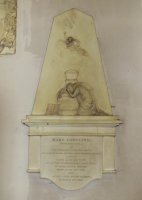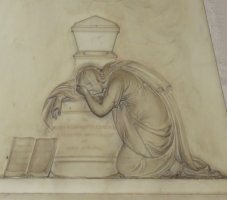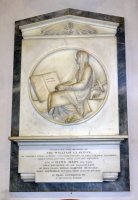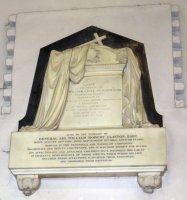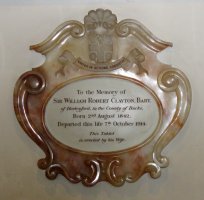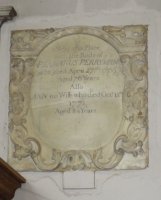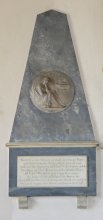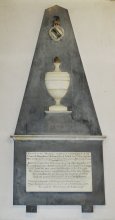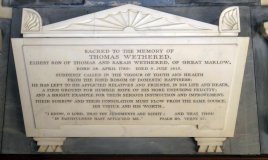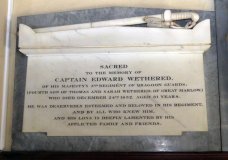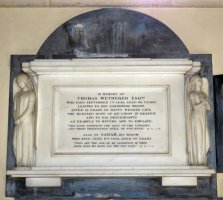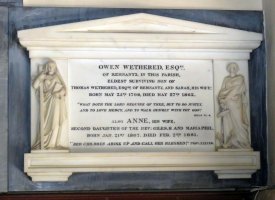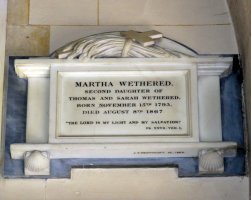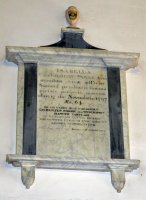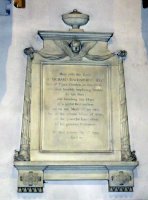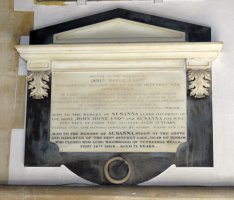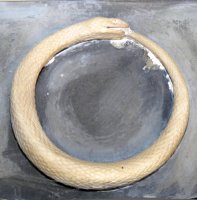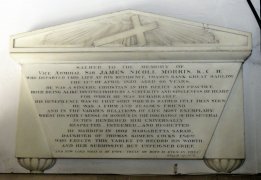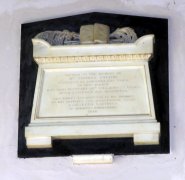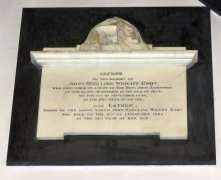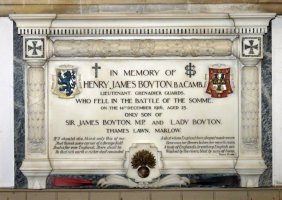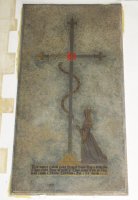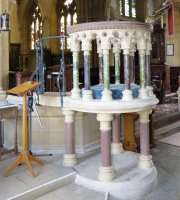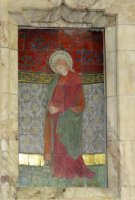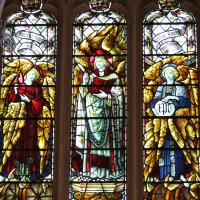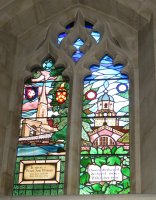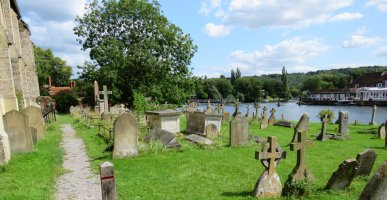All Saints Church, Marlow, Bucks - Monuments
All Saints Marlow, Buckinghamshire is a large 1830s church with over 40 monuments, 20 kept from the previous church on the site. A range of monumental panel types, and a fair selection of sculptors are represented. Click any picture to enlarge, or hover for caption. This page gives a full description of the monuments - if you only have 10 minutes, see this page.
All Saints Church, Marlow.
The Church, dating from 1835, is an imposing edifice next to Marlow Bridge. It replaced an ancient largely Norman structure which was pulled down due to damp, and is of pale Staffordshire brick and Bath stone, with tall windows, red tiled roofs, and a tower with chequerboard flint patterning at the upper level, surmounted by a tall, crocketed stone steeple. Charles Frederick Inwood was the architect, John Oldrid Scott, son of the famous George Gilbert Scott, redid the chancel in 1875-76, and the spire and upper tower were repaired and rebuilt at the turn of the century (so these knapped flints are Oldrid Scott's).
Inside, the height of the Church is very apparent, with dark wooden roof above the nave, separated from the aisles, similarly roofed, by thin pillars and Gothic arches so that the whole is a single space. Monotony is avoided and a degree of ambience imparted by the walls being studded with the monuments we have come to see, together with various hatchments and ecclesiastical furnishings.
Chancel, and several of the monuments.
We have one great kneeler monument from end of the 16th Century, one 17th Century one, and around 40 later ones, mostly white-on-black panels, and plain white ones. They include several figure pieces, and a good selection of several of the popular types of the more simple panels. Sculptors represented include a minor piece by Nollekens, Sir Richard Westmacott RA and two of his sons, a nice mourning girl by John Bacon Junior, and several of the more prominent early 19th Century monumental sculptors. We take them in date order, with diversions for the numerous Clayton and Wethered panels.
Monuments
Catheryne Willoughby, d.1597, a kneeler monument with a touching eulogy by her husband, William Willoughby, writing of 'so rare a wyef, P'formde [performed] these duties of love never dyinge, behold this toombe, with a regarding eye, and reade my losse her worth which here doth lye'. Both husband and wife are shown, in the traditional pose, kneeling and praying, facing each other across a prayer desk. He wears armour and a ruff, she has thick black robes, headpiece, and a larger ruff. Both kneel on the conventional tasselled cushions. Behind them are ranked their offspring, three small male figures behind their father, the first of whom has a beard while the other two are boys, and three girls behind their mother. To the sides, colourful marble Corinthian pillars support a broad shelf on which sits a central painted shield of arms within strapwork, with the flanking arms of each parent. The deep base is supported on side and central curly brackets, with a double apron between bearing light gilt strapwork; below this is further strapwork in the form of large s-shaped devices and a central circle, with small flowers carved in low relief. Made in alabaster, with paint, gilt and cabuchons at the base, this is a colourful and noble monument.
Sir Myles Hobart, Knight, d.1632.
Sir Myles Hobart, Knight, d.1632 [also spelt Sir Miles Hobart], with a bust of the deceased in pale stone, broad, blank faced, with sweeping down hair to the sides and a moustache, a large ruff, and cloak across his breast. On each side, a small standing alabaster figure, male and female, hold back curtains, and these form the pillars supporting a heavy pediment above, with a now blank cartouche of arms in the centre. To one side, the surviving base of a lost pair of some ornaments, perhaps small urns or obelisk. An oversized modern shelf beneath, and then the inscription in gilt on black as is normal for the period, and a basal winged cherubic head, alabaster again. Immediately underneath is a small plaque showing a carriage and four horses plunging down a hill, in stone; it is how Sir Myles died, going down Holborn Hill. Figure pieces like this, usually kneelers, but quite often forward-facing, lasted around a century from the 1550s to the 1650s, so Sir Myles' one is quite late in the period. There is quite a variety, but the use of a male and female figure to hold back the curtains, rather than a pair of male figures (e.g. men at arms) or female (angels or allegorical girls) is not at all usual, and we might speculate that they may represent the children of the deceased, in which case the likelihood is that there is a lost inscription about them, along with whatever else this monument originally comprised.
George Bruere, d.1721, with a Latin inscription. Plain panel with thin border, cut to semicircle above to allow for a shield of arms above the inscription; there is a shelf below.
Catheryne Willoughby, d.1597.
Clayton Family
It was on the roof of the Clayton family vault that in 1790, a workman painting the spire fell 70ft from the scaffolding, via the battlements of the tower, and escaped without fracture. We take the Clayton monuments in date order, and then go back to the others.
Mary Clayton, d.1760, wife of William Clayton of Harleyford. Really a nice monument, unfortunately obscured. The basic composition: oval inscribed panel within a rectangle with a central painted coat of arms, pot on top, apron below, is common enough, but here we have a Baroque version, wilfully exaggerated to give a flamboyance and lightness. Thus the top corners of the rectangle are drawn out, surmounted with curly shelves, the shield of arms in a small cartouche with swept back and forward petals , and the pot on top has a pear shaped body, bell-like top, large S-shaped handles and an oversized floral wreath upon it. The apron at the base is a curly, leafy construction like a Japanese goldfish tail. A most excellent thing.
Bacon's monument to Mary Caroline Clayton, d.1812.
Mary Caroline Clayton, d.1812, a child, daughter of the Baronet and grand-daughter of another on her mother's side. An obelisk monument with carved figures. Thus the composition centres on the figure of a girl slumped in grief against a monument to the deceased, one arm thrown forward, the other hand against her brow. She is finely draped in Classical vein, with a nice swirl to the lines of her cloak around her bowed body. A book rests open against the other side of the tomb, to provide a degree of balance. Above, a small winged figure glides, presumably the departing soul, glancing downward but with hand raised aloft, seated on a cloud. Beneath the scene, is a shelf, and then the inscribed panel with borders to top and sides, and a wavy lower edge. This accomplished work is signed by Bacon, who is John Bacon the Younger, maker of many good monuments. (For lots more classical girls, see this page.)
Sir William Clayton, Baronet, d.1834, with a carved figure in a roundel. She is seated, lower legs to one side - a most natural posture but highly unusual in monumental sculpture of this period - her hands together on her lap, almost as if in prayer. She wears classical drapes, but also a cowl looking more medieval, and behind her is a cross. In front, an open book with the words 'Thy will be done'. This subtle piece is by the sculptor Sir Richard Westmacott RA, of great renown and prodigious output of monuments. For the rest, we have a pediment above with a sunburst, and the inscription below separated from the main portion of the monument by a shelf. On a grey streaky marble backing.
Clayton family monuments, 19th Century (hover for captions).
George Frederick Culpeper, d.1847, grandson of Baronet Sir William Clayton, who died aged aged just 7 from a fall off a pony at maidenhead. Plain plaque with upper shelf on a black backing.
William Capel Clayton, d.1848, of the Coldstream Guards, 'a magistrate and deputy lieutenant of the County of Buckingham', eldest son of General Sir William Robert Clayton, Baronet, d.1866, also commemorated. The inscription to the son is on a tomb chest, covered with a nicely carved asymmetric drape, a cross at the top, a partially covered wreath on the pediment. The Baronet's inscription is on the base, and below, two supports carved with rounded flower petals. Picture above right, click to enlarge.
Lt Capt Charles Edward Ferdinand Clayton, d.1886, son of H. H. Clayton and Augusta, daughter of the 2nd Baronet Oakeley. Simple white-on-black panel with upper pediment bearing a shield of arms carved in low relief, a lower shelf, and a shaped backing.
Sir William Robert Clayton, Baronet, d.1914. A small cartouche, simplified from the complex structures of the 18th Century, but nevertheless well-conceived. The inscription is in a horizontal oval of white marble, with the surround in the pinking alabaster much cherished at this time, with simple S-shaped curls and a shield of arms carved in high relief at the top. Picture above.
That is it for the Clayton monuments, and now we return back to the mid-18th Century and carry on with the other panel monuments:
John Ellison, d.1743, his wife Ann Ellison, d.1752, and others of the family through to 1800. Oval panel with bevelled edge resting on a shield of arms attached to a later monument below. This second panel is is to George Ellison, d.1830, his first wife Mary, d.1808, and their eldest daughter Mary Sophia Ellison, d.1871. This later panel is a fairly ornate casket end, thus with outward sloping sides, curvy corrugations to these to form pilasters, an upper 'lid' with delicately carved scrolling and anthemion design, and beneath, two feet resting on a separate shelf (for explanations of different types of white-on-black panels, see this page). On a black backing, and signed by a good statuary: Thomas Denman of 83, The Quadrant, Regent Street.
Skulls and bones for Permanus Perryman (click to enlarge).
Permanus Perryman, d.1769, and his wife Ann Perryman, d.1771. An unusual design, being sort of a cartouche - thus with oval centre bearing the inscription and a thick surround carved with scrolls and leaves, but set on a square backing, and with an upper curved shelf, leaving corners filled with skulls and bones. Interesting.
Obelisk monuments to the Cleoburey family.
Elizabeth [Keen] Cleoburey, d.1777, wife of John Cleoburey DD noted below. Another obelisk monument, the obelisk in dark streaky marble, taller than usual compared to the inscription on the panel below. The obelisk bears a roundel with a carving of a seated girl next leaning on her elbow, staring down contemplatively, supposed to represent Religion; in low relief in the background is a pillar bearing a broad urn. A second obelisk monument is to the Revd. John Cleoburey, d.1800, Vicar of Abingdon and Medmenham, and the Revd. John Cleoburey DD, d.1801, '53 years the pious, practical Minister of this Church' and 40 years a magistrate. The obelisk occupies around two thirds of the height, bearing upon its face a flaming urn carved in relief in white marble, with painted cartouche of arms above; the pot is on a plinth with a brief Latin inscription. Then the usual dividing shelf, and beneath, the full inscription on a plain panel.
Wethered monuments
Our second interruption to our chronology, to pick up the long sequence of Wethered monuments. Starting later than the Claytons, what we have is a series of white-on-black panels, and plain white ones, characteristic of their time. They include two with figure sculpture by members of the Westmacott family of sculptors.
George Wethered, d.1783, his second wife Ann Wethered, d.1794, and two infant grandchildren, Samuel, d.1794, and Emma, d.1796. White panel with frame, semicircular top bearing a shield of arms, and a lower shelf with moulding.
Thomas Wethered, d.1815. A casket end, with outward sloping sides, lid with acroteria and weblike sunburst, and little feet with dogteeth. On a dark backing. Picture below left.
Early 19th Century Wethered panels (hover for captions).
Captain Edward Wethered, d.1832, of the 3rd Regiment of Dragood Guards. Tomb chest end with a delicate carving of a sheathed cavalry sword on top, with a nicely conceived tassel. On a shaped grey backing.
Richard Westmacott RA (Jun), panel to Thomas and Sarah Wethered .
Thomas Wethered, d.1849, and his wife Sarah Wethered, d.1856. Tomb chest end with feet, and upper and lower shelves, and to the sides, in place of pillars, small, charming figures of angels, like Pre-Raphaelite girls in the style of Rossetti's Annunciation. One stands head down, hands one on the other, in mournful contemplation, while the other looks upward, her hands crossed on her breast. The dark backing panel rises in a curved pediment above, suggesting there was some central device once, now lost - perhaps a broad pot. Signed by Richard Westmacott RA, junior, whose more illustrious father we met in the monument to Baronet Clayton, d.1834, above. See this page for more on the Westmacott dynasty of sculptors.
Owen Wethered, d.1862, son of Thomas Wethered, and his wife Anne [Peel] Wethered, d.1881. A rather similar composition to his parents' monument, with small a small figure at each side, shelf below and a pediment above, though the backing panel is a plain rectangle here. The figures are standing females, human rather than winged angels. She to the left carries a tall cross and a Bible, thus represents Faith, and she to the right rests her hands on the top of an anchor, likely emblematic of Constancy rather than Navigation as the family's business was brewing. As with the earlier piece, the figures are well sculpted, particularly she on the right, with her shawl over her arms and chest, medieval fashion. The sculptor, who signs and dates his work 1864, was another of the Westmacott dynasty, James Sherwood Westmacott, a nephew of Sir Richard - he was a portrait sculptor, and made statues for Burlington House, and it is really quite unusual to find a monument by him.
Work of sculptor J.S. Westmacott (hover for captions).
Martha Wethered, d.1867, chunky little tomb chest end, with receding sides, upper and lower shelves, a curvy design of a cross and a sheaf of wheat (likely emblematic of being harvested in the fulness of her time, for she had passed her Biblically allotted 'three-score-years-and-ten'), and feet with finely carved scallop shells. On a dark shaped backing, and again signed by the sculptor J.S. Westmacott, 1868.
Colonel Joseph Robert Wethered, d.1942, his son Major Guy Ernest Fitzgerald Wethered, d.1944, who died of his wounds in Burma, son in law Captain James Makepeace Thackeray Ritchie, d.1940, killed in action on France, and on a separate little panel, Kathleen Dorothy Amy Wethered, d.1972, his wife. Plain panels with painted regimental shields of arms.
So much for the Wethered family - we return to them in the 'Also in the Church' section; back to our roughly chronological order of other panels:
Eleanor Blake [Hughes] Parke, d.1788, erected by her husband and mother, and leaving an infant daughter. With inlaid vertical stripes of red marble to the side pilasters, a thick shelf above bearing a canopy with a ball on top, and curly brackets below. Just below it is a knight's helm of ancient date.
Isabella Parke, d.1797, white on black panel, the white marble being rather streaked, with side pilasters, upper and lower shelf, with on top a small pot bearing a shield of arms, on a broad base which if it had been bigger could have become a pediment. Brackets at the base.
End 18th Century panels.
Richard Davenport, d.1799. The inscribed panel has a moulded border, a winged cherub head on top, with small drapes festooned across to upturned torches (symbols of extinction of life) which form pillars to the sides. At the top, a shelf and then a small funereal urn. At the base, another shelf, under which two blocky supports are decorated with a toothed design and low relief quatrefoil flowers. A minor work by the important sculptor Joseph Nollekens. Picture above right.
Thomas Langley, d.1801, his wife Mary Langley, d.1802, and the Revd. Thomas Langley, d.1801, 'author of the History of the Hundred of Desborough and Deanery of Wycombe'. In describing Marlow, he showed approval for demolishing older buildings such as the Market House ('a miserably heavy building of timber, of very ancient date' as Marlow 'is capable of becoming a very neat country town'. This 'neat country monument', if so I may describe it, is cut with a wavy base, receding sides and has a shelf above. Would that it had some 'heavy' ornament upon it.
Joseph Plumridge, d.1800, and his wife Rebecca Plumridge, d.1810. With upper shelf with mouldings, and a base with an apron, partially concealed.
George McLane, d.1805, his mother Frediswed McLane, d.1816, and father John McLane, d.1823, and one unnamed daughter and two sons. Tomb chest end, with black border, upper pediment bearing a carving of a snake, and acroteria to the sides, and blocky feet containing circles. The rather simple snake, which would normally be biting its tail (as in the John Hone monument noted below), is here doubly coiled and contemplating a bite.
William Hickman Jr, d.1821. With an asymmetrically draped pot, sharply carved, above the inscription, with a shelf between. A bit of a composite piece; the black backing is cut to an egg shape above, with a little moulding cut out at the sides. The piece is signed by William Pistell of the New Road, London: he has an almost identical piece to Arthur Balfour, d.1817, in Marylebone Church. There is also a little brass panel, unornamented, to his third son, George Hickman, d.1861.
John Hone, with carved snake.
John Hone, d.1824, and added later, his daughter Susanna Hone, d.1844, and his wife Susanna Hone, d.1869, who was daughter of the Revd. Stephen Gage, Vicar of Bisham nearby. An interesting white on black monument. The inscribed panel sits under an oversized shelf, allowing for two side pieces with descending acanthus leaves. Above, a plain pediment, and at the base, a small snake biting its tail, which is a nicely pagan Nordic symbol of rebirth. On a black shaped backing. The snake and leaves are delicately carved.
Vice-Admiral Morris, by sculptor John Ternouth.
Vice-Admiral Sir James Nicoll Morris, d.1830, with a eulogy, erected by his wife Margaretta Sarah [Cocks]. Casket end, all in white marble, with the lid bearing a leaning cross in front of a sunburst, and the feet of the rounded, jelly-mould type. A neat monument. The sculptor was John Ternouth, best known for designing one of the panels at the base of Nelson's Column.
Elizabeth Barnes, d.1834. White panel within darker frame, large to sides and top so it looks like a triumphal arch. To the sides are downward pointing torches (life snuffed out) and poppy seed heads (memory) carved in relief, and rounded battlements at the top. On a black backing.
Maria Peel, d.1834, simple tomb chest end with upper shelf and bulky top, and cut with feet below, on a shaped black backing. She was daughter of the Revd. Giles Haworth Peel, and his wife, also Maria - monument noted below.
Martha Higginson, d.1840, widow of Alexander Higginson, white panel with frame, cut to pediment shape above, blocky shelf and supports below. Above it is a panel to the Revd. Henry Higginson, d.1848, rather more humble, but still cut with a pediment, and here, acroteria to the sides. He is recorded as being Chaplain to the East India Company and Minister of Poplar Chapel.
Thomas Taylor, d.1815, erected by his niece Elizabeth Nattriss, in 1846. White on black panel, styled as a tomb chest end with on top, a nice carving of crossed, wilting branches with an open book in front; signed on the shaped black backing panel by H. Wood of Bristol.
1840s tomb chest ends: Taylor and Wright.
John Snelling Wright, d.1848, 'who died while on a visit to The Revd John MacKinnon, at the Manse of Kilbride, in the Isle of Skye', and his wife Esther Wright, d.1865. Tomb chest end cut with feet below, shelf above, on which rests a 'lid' and draped pot carved in high relief. On a rectangular black backing.
The Revd. G. H. Peel, d.1854, incumbent of Ince, Cheshire, and his wife Maria Peel, d.1849. As for their daughter Maria Peel, noted above.
Francis Smedley, d.1859, High Bailiff of Westminster, his only son Francis Edward Smedley, d.1864, and his wife, coincidentally named Frances Sarah [Ellison] Smedley, d.1876. As a tomb chest end, with upper lid and base with rounded feet. On a dark, streaky grey backing panel supported on two small blocks. Signed by Forsyth, Edward Street, Hampstead Rd, London.
Lieut. Boyton, d.1916.
Lieutenant Henry James Boyton, d.1916, of the Grenadier Guards, who fell in the battle of the Somme. Crisp panel with carved, painted shields of arms, and the border made of carved cracker-like shapes with stylised leaves and berries. There are inlaid crosses at the upper corners, and a line of tiny inlays above, beneath a shelf. At the centre of the base, a stylised cartouche with a small gilt design, and crossed boughs underneath, and paddles. With a thin serpentine surround. A well made and unusual panel.
Samuel Bath, d.1953, organist and choirmaster of the Church for 48 years, and his wife Elizabeth Mary Bath, d.1943, plain panel with frame.
Sir John Evelyn Leslie, d.1966, founder of the Royal Over Seas League and English Speaking Union: plain plaque on black backing.
Brasses
I did not see any of the ancient brasses described by the Revd. Langley whose book was noted above. Of the modern brasses we may note:
Sarah Morris, d.1842, one of a really unusual pair of monumental slabs. A modern brass on speckled stone, with the inscription round the frame on a brass border; and in the centre a tall cross, with an angled square in front, coloured blue, and a red 8-pointed star within it, bearing a sigil. The tall stem bears leaves akin to crocketing of a spire, and the base bears the Lamb of God, on a base noting that a sister, Catherine Vernon (see below) gave the monument. To the sides, two shields of arms.
Slab with brass to Catherine Vernon.
Catherine Gladell Vernon, d.1844 (I think). The sister of the above, and an equally unusual modern brass on a slab of stone. A tall, thin Cross fleury (i.e. with little fleurs-de-lys at the ends of the branches and top - there are various cross designs described on the page about churchyard monuments with crosses), standing on three steps, has a ribbon with Biblical quotation wound round it; at the base is the kneeling female figure representing the deceased. She is not so much like an ancient kneeler figure: more shapely despite the bulky clothing than was usual then, and with the lines of the drapes in modern style. She wears a cowl over her shoulders, and has very deep-hung arms, again not in medieval fashion. And impractically, she kneels on a hard stone rather than the soft tasselled cushion to protect the knees that her forebears always have.
Archibald Edward Murray, d.1893. Typical of its time, with red spiky lettering, and a border of inscribed black lines with simple repeating designs and fleurs de lys at the corners, and a raised centre to including a cross. Signed by the makers, Hart, Son, Beard and Co.
Also in the Church
Several hatchments, adding to the sense of fullness of the walls.
Victorian furnishings, including the Victorian font, circular with arches enclosing crosses in circles around it, raised on six clustered pillars with dark and red shafts alternately around a central support, and with a tall wooden cover with curvy steeple and balustrade bearing spirelets. Also a pulpit, looking more recent but of similar date, raised on four pillars, with an open balustrade of pillars: the shafts are alternating green serpentine and purple Plymouth marble above, very streaky and bold, and pink sandstone below - very modern for 1863. And a typical brass eagle lectern as found in so many churches, and some ironwork - see pictures below.
Victorian furnishings (hover for captions).
The reredos has a spiky late Victorian Gothic top, and indeed dates from Oldrid Scott's 1876 makeover, but the carved inscription and the glazed tile mural of Christ on the cross with attendant females to the sides looks really rather Arts and Craftsy.
A panel noting that Charles Alan Smythies, d.1894, Bishop of Zanzibar and one time curate of the parish, gave the oak panelling, sanctuary chairs and credence table.
Various stained glass windows, including several to members of the Wethered family, including a very good group of angels to Lawrence Wethered, d.1890, and modern ones with architectural pictures.
A painting of a young boy, with white and black patches of skin, with bow and arrow, standing in a wilderness. Presumably this is the picture by Congreve, made for John Richardson.
Mothers' Union cloth banner with an infant Christ held by the Virgin Mary.
A war memorial window for WW1, with wooden panels below recording those who died, and a circular shield, to WW2 losses.
A wooden screen of open tracery, very delicate. Wooden panels note the founding of the chapel so enclosed in 1925, and notes Thomas Owen Wethered, d.1924, who was MP for Marlow, and others of the family.
Stained glass in the Church.
Churchyard
The churchyard is next to the River Thames, with fine views, and a nice place to sit by the water, most peaceful. There is a fair selection of upright tombstones, including a good collection of variations on crosses (again, see the page about such things), mostly 19th and early 20th Century but with a few 18th century pieces. There are also a few larger monuments. A pleasant little wander among the tombstones reveals a few gems.
Several tombs to members of the Wethered family. 19th Century and later, right up against the Church wall, with railings.
A big pink granite obelisk to the Carson family, mid Victorian, with a darkened praying angel, kneeling, and arms.
A couple of iron grave markers, which were never that popular and always worth a look. One of these is to Blanche Agnes Howard, d.1862 and Frank James Howard, d.1863, both young children, with wrought iron decoration like part of some gate.
A few taller stone pieces, including a fine pedestal to Eliza Barrett Hammond, 1870s but looking older.
A gravestone to the watercolourist and accomplished black-and-white illustrator E.J. Gregory, with carved palette and brushes.
A large monument by the Church built in stages: a great square base with corner blocks, then a plinth, supporting a cross on steps.
The Wiggington family gravestones. Each with a similar wavy upper with 'ears' and low relief carving of a winged cherub head and scrolly foliage.
A couple of large tomb chests, 19th Century, and one angled one like an open tomb, to Louisa Mary Desborough Man, d.1874, and husband Edward Desborough Man, d.1893.
Finally, over the Church wall can be seen an impressively large Tudor-style building of flint, brick and stone, with tile roofs and tall chimneys. This is Old Bridge House, and in fact is 19th Century; there are other good architectural things around Marlow town centre to see.
The Church website is at https://4u-team.org/churches/all-saints-marlow/.
Also in Marlow: The Frohman memorial statue.


